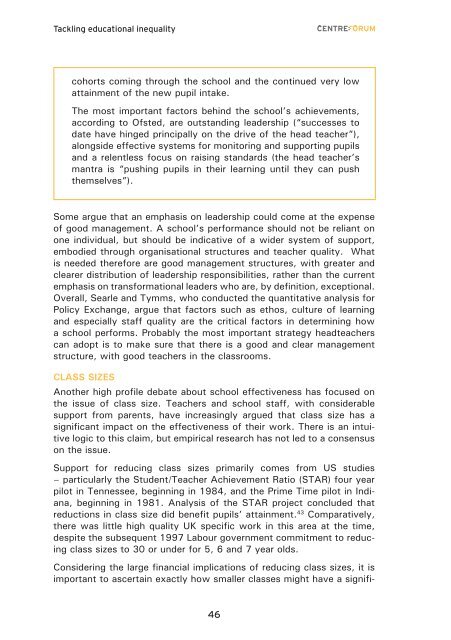Tackling educational inequality - CentreForum
Tackling educational inequality - CentreForum
Tackling educational inequality - CentreForum
Create successful ePaper yourself
Turn your PDF publications into a flip-book with our unique Google optimized e-Paper software.
<strong>Tackling</strong> <strong>educational</strong> <strong>inequality</strong><br />
cohorts coming through the school and the continued very low<br />
attainment of the new pupil intake.<br />
The most important factors behind the school’s achievements,<br />
according to Ofsted, are outstanding leadership (“successes to<br />
date have hinged principally on the drive of the head teacher”),<br />
alongside effective systems for monitoring and supporting pupils<br />
and a relentless focus on raising standards (the head teacher’s<br />
mantra is “pushing pupils in their learning until they can push<br />
themselves”).<br />
Some argue that an emphasis on leadership could come at the expense<br />
of good management. A school’s performance should not be reliant on<br />
one individual, but should be indicative of a wider system of support,<br />
embodied through organisational structures and teacher quality. What<br />
is needed therefore are good management structures, with greater and<br />
clearer distribution of leadership responsibilities, rather than the current<br />
emphasis on transformational leaders who are, by definition, exceptional.<br />
Overall, Searle and Tymms, who conducted the quantitative analysis for<br />
Policy Exchange, argue that factors such as ethos, culture of learning<br />
and especially staff quality are the critical factors in determining how<br />
a school performs. Probably the most important strategy headteachers<br />
can adopt is to make sure that there is a good and clear management<br />
structure, with good teachers in the classrooms.<br />
Class Sizes<br />
Another high profile debate about school effectiveness has focused on<br />
the issue of class size. Teachers and school staff, with considerable<br />
support from parents, have increasingly argued that class size has a<br />
significant impact on the effectiveness of their work. There is an intuitive<br />
logic to this claim, but empirical research has not led to a consensus<br />
on the issue.<br />
Support for reducing class sizes primarily comes from US studies<br />
– particularly the Student/Teacher Achievement Ratio (STAR) four year<br />
pilot in Tennessee, beginning in 1984, and the Prime Time pilot in Indiana,<br />
beginning in 1981. Analysis of the STAR project concluded that<br />
reductions in class size did benefit pupils’ attainment. 43 Comparatively,<br />
there was little high quality UK specific work in this area at the time,<br />
despite the subsequent 1997 Labour government commitment to reducing<br />
class sizes to 30 or under for 5, 6 and 7 year olds.<br />
Considering the large financial implications of reducing class sizes, it is<br />
important to ascertain exactly how smaller classes might have a signifi-<br />
46





